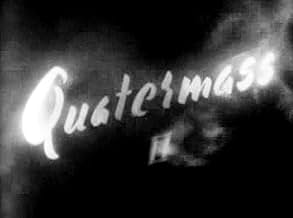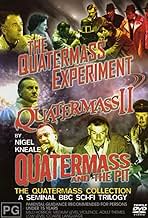अपनी भाषा में प्लॉट जोड़ेंProfessor Quatermass is trying to perfect a dangerously unstable nuclear-powered rocket engine. After a disastrous test firing in Australia, his soon-to-be son-in-law, Captain John Dillon, d... सभी पढ़ेंProfessor Quatermass is trying to perfect a dangerously unstable nuclear-powered rocket engine. After a disastrous test firing in Australia, his soon-to-be son-in-law, Captain John Dillon, draws the Professor's attention to a strange hollow meteorite which interrupted an Army Tra... सभी पढ़ेंProfessor Quatermass is trying to perfect a dangerously unstable nuclear-powered rocket engine. After a disastrous test firing in Australia, his soon-to-be son-in-law, Captain John Dillon, draws the Professor's attention to a strange hollow meteorite which interrupted an Army Training exercise. Quatermass and Dillon investigate, and discover a vast government producti... सभी पढ़ें
फ़ीचर्ड समीक्षाएं
The story by scifi specialist Nigel Kneale was hi-tech stuff then. Alien spores infiltrated the earth's atmosphere crashing to earth in small rock-size meteorites. On contact by individuals, the smallest stream of vapor would escape and enter the victim who became "one of them" - looking unchanged, but "taken over" body-snatcher style! As always, a major Government cover-up allowed an enormous domed plant to be built - quite impenetrable and unaccountable seemingly to anyone. Of course, once Bernard Quatermass was on the case, things moved along.
The first real horror came at the end of episode 2 I think when Quatermass stumbles across some poor worker who has tumbled down a flight of metal steps having tried to get into the dome. He is covered with a black shiny resin burning him to death. Might sound a cack now, but in 1955 it was gruesome and horrific. As the extent of the "takeover" becomes apparent, Quatermass and his small team of assistants realise they must break into the dome at all costs. What they find is seared on my mind for all time. The dome is full of boiling slimy protoplasmic shapes which rear up as the camera pans closer..thats the only way to describe them, existing in an artificially created environment which is a replication of the conditions upon their own asteroid. As the credits rolled on that episode, not too many people in Britain would have been saying much!
Ultimately, the dome is destroyed despite the "thing's" valiant attempts to defend their earth-base. The concluding episode saw the locating of the asteroid and Quatermass's final flight there to destroy the alien threat. One would today laugh at both the rocket and the alien life-forms as they all but crushed the ship in the dying seconds. You wouldn't have laughed in 1955!
Val Guest's big screen remake: ENEMY FROM SPACE many years later, was certainly OK but could never hold a candle to this original work which as many have commented is just about impossible to find. I actually have a softcover book of this great film series, complete with the entire dialog and several plates from the old black and white serial. It is one of my favorite possessions.
All things considered, I guess I prefer the films to the serials for two reasons: one, the fact that the former - even if still done on a low budget - were invariably more polished (given their crisp photography as opposed to the fuzziness of a TV program); the other reason is the essential tautness of the films - the serials don't necessarily feel draggy and are certainly never boring but, watched in one sitting (which, I guess, was never the intention to begin with!), Kneale's gripping and thought-provoking plots could make for a tiresome overall experience!!
John Robinson replaced Reginald Tate (who had died in the meantime) as Professor Quatermass; he does a good job at it but, from the three actors who performed the character on TV (I haven't watched John Mills in the final serial, named simply QUATERMASS, from 1979), he's the one who comes closest to Brian Donlevy's interpretation in the first two films and which so dissatisfied Kneale! The cast also features Hugh Griffith as Quatermass' assistant and future stalwart of British horror cinema Rupert Davies as a government official.
The fact of these being live broadcasts was betrayed more than anything else during this particular serial by the surprising number of lines flubbed by the actors throughout - chief among them Robinson himself! Besides, even if scenes that were made memorable by the films (which I obviously watched prior to the serials) generate their own tension and excitement on the small screen, the film's ending is preferable to the one presented here - in which Robinson and Griffith are flown into outer space in order to destroy the planet which was attempting to colonize Earth.
Another plot addition is the introduction of little metallic cases to contain the aliens in and make them more readily available for transportation to one victim to another, a side plot sadly missing from the afformentioned Hammer film. The story is slow to build up, but once it gets going there is no stopping it and you soon become deeply involved in the plot. The character Broadhead from the film version is called Ward here and it is only a 3 man expedition that enters the Synthetic Food plant at Winnerden Flats, during this visit Ward dies covered in black slime and Quatermass and a character called Fowler discover to their horror that a nearby picnicking family have been gunned down by the impossing Zombie guards. Altogether a fantastic serial in all 6 parts (complete for those that are still hanging onto the belief that all or some of the episodes are missing). News is doing the rounds that the serial may be making it's way onto DVD this year and hopefully it will make it.
क्या आपको पता है
- ट्रिवियाThirty workers from the Shell refinery participated in the riot scenes filmed for The Frenzy (1955).
- गूफ़During the rocket launch in Episode 6, the rod supporting the model rocket can be seen.
- भाव
Prof. Bernard Quatermass: Dillon, there's something on your face!
- इसके अलावा अन्य वर्जनEpisode Three ("The Food") was broadcast in 1991 as part of the programming celebrating the history of the BBC's Lime Grove facility. In order to fit into the half-hour timeslot, several minutes of footage were cut from the episode.
- कनेक्शनFeatured in Bite Back: एपिसोड #1.19 (1993)
- साउंडट्रैकZero Minus Sixty
Composed by Robert Farnon
Performed by The Melodi Light Orchestra
Conducted by Ole Jensen
Courtesy of Chappell Recorded Music Production Library
टॉप पसंद
- How many seasons does Quatermass II have?Alexa द्वारा संचालित
विवरण
- रिलीज़ की तारीख़
- कंट्री ऑफ़ ओरिजिन
- भाषा
- इस रूप में भी जाना जाता है
- Квотермас 2
- फ़िल्माने की जगहें
- उत्पादन कंपनी
- IMDbPro पर और कंपनी क्रेडिट देखें
- रंग
- ध्वनि मिश्रण
- पक्ष अनुपात
- 1.33 : 1
इस पेज में योगदान दें























